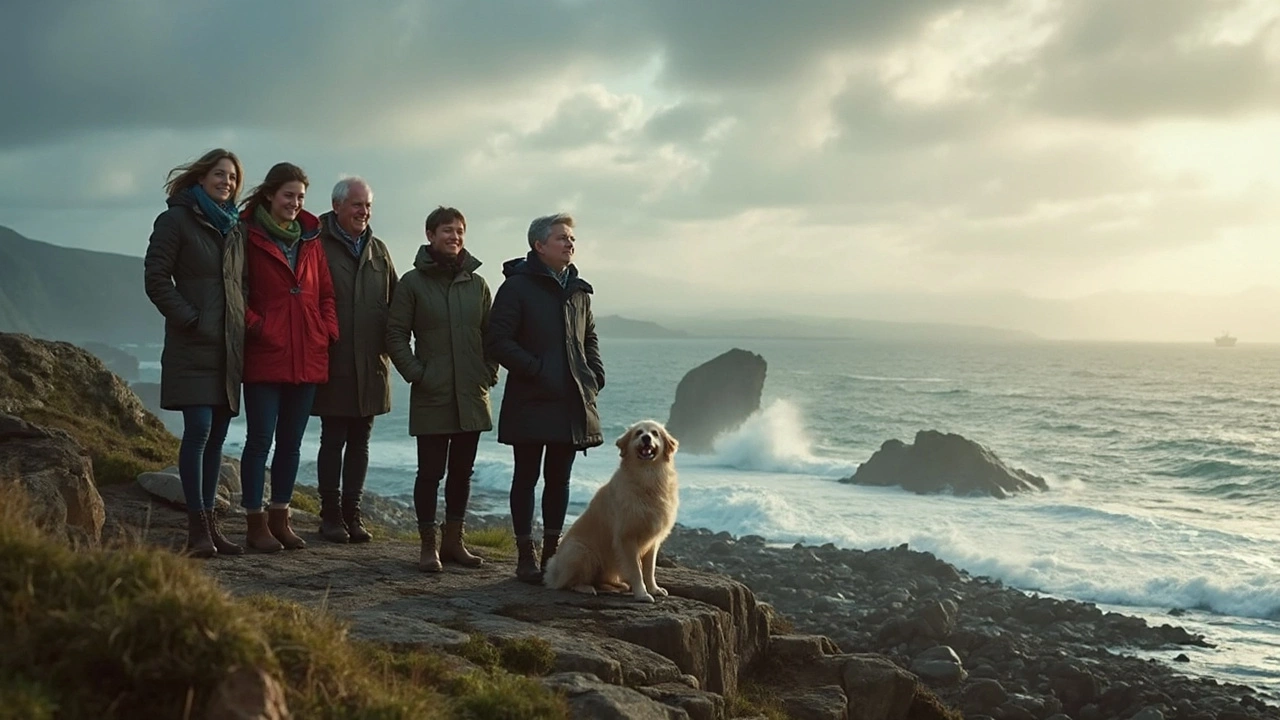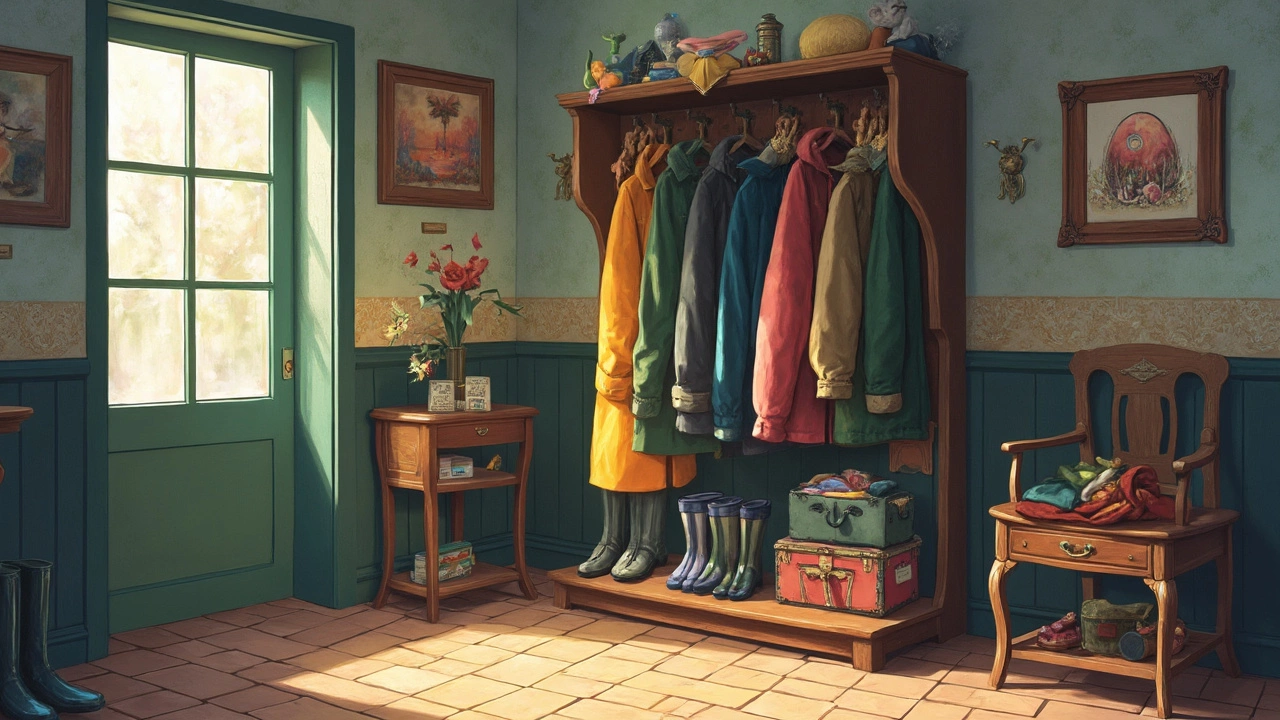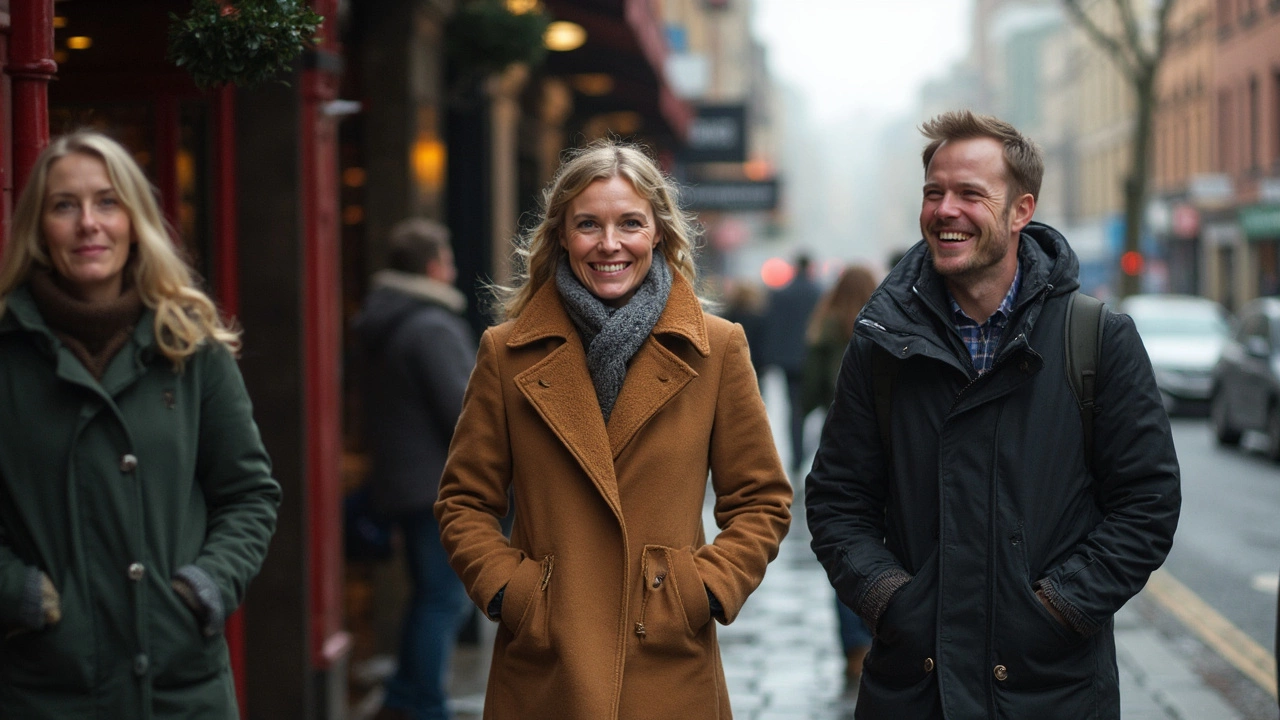Step outside in Dublin on a drizzly March day and you can bet you’ll see someone in a Penneys jacket debating if they need another layer. But if you flip through American street style photos, people bundle up in hefty coats, even when the sun’s shining. So what’s going on—why the fuss over coats across the pond? And should folks in Ireland be taking notes, or just shaking their heads?
This isn’t just about style—there’s real thinking behind those coat choices, often tied to how Americans deal with the extremes in temperature. In Ireland, we’re more used to quick changes—a sunny lunch in Phoenix Park can turn soggy by teatime, but rarely do temperatures nosedive like they do in Boston or Chicago. So, while Americans might reach for big padded jackets or parkas, here you’re more likely to get away with a good rainproof shell or a GAA hoodie layered underneath.
If you live in Galway or Cork, you know the weather shifts every hour. That’s why picking the right outerwear here is less about hugging a trend and more about blending practicality with a dash of local flair. Think Blanchardstown’s outdoor markets, where seasoned stallholders swear by waxed cotton, or hiking on the Wicklow Way where a lightweight jacket saves you every time a cloud turns nasty.
- Why Americans Obsess Over Outdoor Coats
- Weather Differences: Ireland vs. America
- How Irish Traditions Influence Jacket Choices
- Finding the Right Coat for Irish Conditions
- Handy Tips: Brands, Care, and Shopping in Ireland
Why Americans Obsess Over Outdoor Coats
Ever watched an American movie set in winter? Everyone’s zipped up in hefty jackets, no matter if they’re in New York, Chicago, or even somewhere like Denver. It actually makes sense—the US really does get wild swings in weather. In some places, you’ll see freezing blizzards one week and mild breezes the next. Forget those soft Irish drizzles; think about minus 20 degrees in Minnesota with biting winds. The coat isn’t just part of the outfit—it’s a survival strategy.
For a lot of Americans, outerwear is serious business. Around 60% of people in the northern US own more than one winter coat, according to a 2023 Statista report. Most cities pile on the snow. The further north you go, the heavier the coat. Down south, it’s still common to keep a lighter jacket handy for chilly mornings or over-airconditioned shopping malls.
Wearing coats outside is also wrapped up with activities. Americans drive a lot and often need a flexible coat for everything—walking through snow, waiting for buses, or running errands. The culture kind of pushes everyone to be prepared for the absolute worst, just in case. Even kids in schoolyards show off their North Face or Patagonia puffer coats like trophies.
One more thing: in the US, outdoor brands are everywhere. You’ll see shops stuffed with long lines of parkas, fleeces, and rain jackets year-round. Even in summer, people buy coats in case the weather flips. When TV or ads show movie stars in the latest jacket, the hype just grows.
- The daily commute in Chicago? That’s a two-coat system: a lightweight for early fall, and a heavy-duty down coat from November through March.
- In the Pacific Northwest, folks lean hard into rain jackets and waterproof shells—Seattle gets almost as many rainy days as Cork, but with colder winds.
- In mountain states like Colorado, technical jackets are standard because of sudden altitude weather drops.
So, it’s no shock that the jackets market in America is booming. The habit of prepping for everything leads to bigger wardrobes than what most Irish folks would bother with. And honestly, if our winters started hitting minus 30, we might all be queuing up for those giant padded parkas too.
Weather Differences: Ireland vs. America
It’s easy to see why the jackets you spot on a New Yorker might not fit the bill for a rainy day in Limerick. The big thing? Climate and temperature swings. America is massive—stretching across time zones and climates, from humid heat in Miami to bone-chilling cold in Minneapolis. That means the average American wardrobe covers everything from huge parkas to light jean jackets.
Now, compare this to Ireland’s setup. We get lots of rain (an average of 225 days a year in places like Valentia), but it’s rare for the temperature to dive below zero or rocket above 20°C. Even in January, Dublin’s average is about 5°C, and you’re unlikely to need a down-filled winter coat unless you’re heading up Croagh Patrick in a snowstorm.
| Location | Average Winter Low (°C) | Average Summer High (°C) | Rainy Days/Year |
|---|---|---|---|
| Dublin, Ireland | 2 | 19 | 128 |
| New York, USA | -3 | 29 | 122 |
| Chicago, USA | -7 | 28 | 125 |
Here, the real hassle is the rain and wind. Waterproofs matter way more than heavy insulation, especially if you’re slogging through College Green or waiting for the LUAS. American cities can freeze for weeks—think Boston blizzards—which explains all those thick puffer jackets and lined parkas. But in Galway or Kilkenny, a well-fitted raincoat often does the trick, even during December’s worst.
The other fun twist? Americans, especially in places like Denver or Maine, often have proper snowy winters where snow boots and woolly hats are a must. Over here, snow is a headline event. Most Irish folks remember the “Beast from the East” because it was so unusual, not because we’re used to meter-high snowdrifts every year.
So, while the US goes for layers built for extremes, Irish people get by with gear meant for every kind of cloud drama—quick-drying jackets, close-cut rain shells, and those reliable umbrellas you find in every shop from Dunnes to SuperValu.

How Irish Traditions Influence Jacket Choices
Jacket choices in Ireland aren’t just about today’s weather—they’re shaped by years of local habits, sports, and common sense. Growing up here, you probably remember being told from age five that “there’s no such thing as bad weather, just the wrong jackets.” Our parents and grandparents prized staying dry above all. You saw that with everyone from farmers in Westmeath throwing on old oilskins, to school kids togged out in the sturdiest raincoats money could buy.
One major influence comes from the GAA and other grassroots sports. GAA club crests show up on jackets and hoodies all over the country, not just for style but because warmth is key when you’re coaching on the sidelines in Carlow or waiting out a squall at a camogie match. And you haven’t really experienced Irish weather until you’ve tried layering a club jacket over a woolly jumper at a winter league game.
Traditional events like ploughing championships, St Patrick’s Day parades, and the Mart in Ennis have always meant hours outside, rain or shine. That’s where heavier coats or Aran wool jumpers hidden under wax jackets come in. Irish brands like Dubarry, Magee, and even Trespass in shopping centres have built business around gear that handles a soaking but won’t look out of place in the pub afterwards.
It’s not just rural habits, either. City dwellers know the pain of waiting for the 46A in January. That’s where practical, waterproof jackets—preferably with a hood big enough for your headphones—take the win. And don’t forget the obsession with pockets: who among us hasn’t bought a jacket just for keys and a Leap Card?
If you’re new to Ireland or figuring out what actually works for a typical year, the unofficial wisdom boils down to this:
- Waterproof comes before warm: An Irish shower can soak you to the skin in ten minutes flat.
- Layering really matters: Combine a light fleece or wool jumper with a windproof shell instead of one heavy coat.
- Heritage counts: Old-school styles like waxed cotton and Aran knits never lose their place, and they actually hold up to the weather here.
- Pockets = lifesaver: Seriously, you’ll thank yourself every week.
Our traditions may look casual or even old-fashioned, but there’s steady wisdom in how we pick what to wear outside. We don’t dress like Americans for a reason—our culture, sports, and weather all pull us in a different, more practical direction.
Finding the Right Coat for Irish Conditions
Choosing the right coat in Ireland isn’t really about looking sharp for brunch spots on Dawson Street—it's about surviving four seasons before lunchtime. The weather is unpredictable, with rain at least half the days in a typical Irish year. So the usual American approach with massive puffers isn’t always a match for our kind of wet and windy. Here, your coat needs to handle sideways rain and surprise chills without boiling you alive indoors.
A good rule? Make jackets waterproof, wind-resistant, and not too heavy. Breathability matters just as much, especially if you’re dashing between Connolly Station and your job or running around St. Stephen’s Green. Something like a North Face Resolve or the classic Regatta is popular for a reason—they’re reliable against our stubborn drizzle.
Pól O’Conghaile, travel writer for the Irish Independent, summed it up: "You don’t need Arctic gear, but you do need a coat that can laugh off rain and won’t turn you into a sauna by the time you hit the bus."
Let’s break down what you really need to look for:
- Waterproofing: Ignore "shower resistant"—fully taped seams and a proper hood are gold. Brands like Helly Hansen and Mac in a Sac shine here.
- Layers: Irish mornings can be Baltic but afternoons feel mild. Go for a coat with a removable liner or enough space for a hoodie underneath.
- Pockets: Zip-up is best—handy for your Leap Card, and saves your phone from a soak if you get caught in a sudden downpour.
- Fit: Too tight and you can’t layer; too loose and you’ll look like you raided your uncle’s attic. Get sized up in-store, especially somewhere like Arnotts or O’Neills.
- Care: Water-repellent sprays and regular cleaning will make any jacket last longer and keep you dry.
If you’re curious about what most people are really buying locally, check out these sales stats from a popular Irish outdoor retailer:
| Jacket Type | Percentage of Sales (2024) |
|---|---|
| Light Waterproof Shell | 38% |
| Insulated Jacket | 23% |
| Padded Parka | 19% |
| Waxed Cotton Jacket | 12% |
| Other | 8% |
Light waterproof shells clearly lead the pack, and that tracks with the reality here: You want something you can trust for a dash to Lidl or hiking around Howth. Don’t waste cash on anything that can’t handle a good dose of mist and always test the hood before you buy—it’s the Irish way.

Handy Tips: Brands, Care, and Shopping in Ireland
Navigating the coat scene in Ireland isn’t rocket science, but picking smart can save you hassle. When it comes to Irish brands, you’ll see names like Magee 1866, Dubarry, and Regatta popping up a lot. Magee is famous for its Donegal tweed—super warm and surprisingly tough. Dubarry’s jackets are a staple for anyone heading to the races or walking the dog along Howth Head. Regatta is everywhere for practical, waterproof gear and doesn’t break the bank.
If you usually hit Galway’s Eyre Square Shopping Centre or Blanchardstown Centre for your outerwear, you’ll find these brands alongside options from international names like The North Face and Columbia. Some folks swear by Penneys for cheap and cheerful jackets. They may not last you forever, but handy to have for festivals or school runs.
Wondering how long your coat will last in the wild Irish weather? It mostly comes down to care. Here’s what locals do:
- Air-dry your coat whenever you can—tumble drying wears them fast.
- If you’ve got a waterproof shell, reproof it once a year. Outdoor shops in Dublin, like Great Outdoors, sell spray-ons that do the trick.
- Treat stains right away. Irish mud is tough stuff. A dab of gentle soap (not too much scrubbing) usually sorts it.
Shopping-wise, if you want to snag a deal, wait for the Black Friday sales or check for outlet stores in Kildare Village—big savings without the city prices. Some stores offer student discounts, especially in Limerick and Cork.
| Coat Brand | Best For | Average Price (€) |
|---|---|---|
| Magee 1866 | Tweed, Classic Looks | 250-400 |
| Dubarry | Rural Walks, Weatherproofing | 200-350 |
| Regatta | Affordable, Waterproof | 40-100 |
| Penneys | Everyday, Budget | 20-50 |
One last tip—Irish weather is brutal on zips and buttons. If something goes, get it fixed in a local alterations shop. It’ll cost less than buying new and keeps your jacket in action longer.
